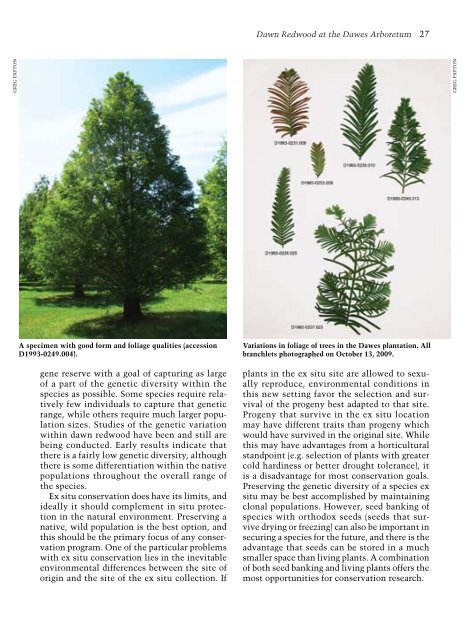The Magazine of the Arnold Arboretum - Arnoldia - Harvard University
The Magazine of the Arnold Arboretum - Arnoldia - Harvard University
The Magazine of the Arnold Arboretum - Arnoldia - Harvard University
You also want an ePaper? Increase the reach of your titles
YUMPU automatically turns print PDFs into web optimized ePapers that Google loves.
Dawn Redwood at <strong>the</strong> Dawes <strong>Arboretum</strong> 27<br />
Greg PAYTON<br />
Greg PAYTON<br />
A specimen with good form and foliage qualities (accession<br />
D1993-0249.004).<br />
gene reserve with a goal <strong>of</strong> capturing as large<br />
<strong>of</strong> a part <strong>of</strong> <strong>the</strong> genetic diversity within <strong>the</strong><br />
species as possible. Some species require relatively<br />
few individuals to capture that genetic<br />
range, while o<strong>the</strong>rs require much larger population<br />
sizes. Studies <strong>of</strong> <strong>the</strong> genetic variation<br />
within dawn redwood have been and still are<br />
being conducted. Early results indicate that<br />
<strong>the</strong>re is a fairly low genetic diversity, although<br />
<strong>the</strong>re is some differentiation within <strong>the</strong> native<br />
populations throughout <strong>the</strong> overall range <strong>of</strong><br />
<strong>the</strong> species.<br />
Ex situ conservation does have its limits, and<br />
ideally it should complement in situ protection<br />
in <strong>the</strong> natural environment. Preserving a<br />
native, wild population is <strong>the</strong> best option, and<br />
this should be <strong>the</strong> primary focus <strong>of</strong> any conservation<br />
program. One <strong>of</strong> <strong>the</strong> particular problems<br />
with ex situ conservation lies in <strong>the</strong> inevitable<br />
environmental differences between <strong>the</strong> site <strong>of</strong><br />
origin and <strong>the</strong> site <strong>of</strong> <strong>the</strong> ex situ collection. If<br />
Variations in foliage <strong>of</strong> trees in <strong>the</strong> Dawes plantation. All<br />
branchlets photographed on October 13, 2009.<br />
plants in <strong>the</strong> ex situ site are allowed to sexually<br />
reproduce, environmental conditions in<br />
this new setting favor <strong>the</strong> selection and survival<br />
<strong>of</strong> <strong>the</strong> progeny best adapted to that site.<br />
Progeny that survive in <strong>the</strong> ex situ location<br />
may have different traits than progeny which<br />
would have survived in <strong>the</strong> original site. While<br />
this may have advantages from a horticultural<br />
standpoint (e.g. selection <strong>of</strong> plants with greater<br />
cold hardiness or better drought tolerance), it<br />
is a disadvantage for most conservation goals.<br />
Preserving <strong>the</strong> genetic diversity <strong>of</strong> a species ex<br />
situ may be best accomplished by maintaining<br />
clonal populations. However, seed banking <strong>of</strong><br />
species with orthodox seeds (seeds that survive<br />
drying or freezing) can also be important in<br />
securing a species for <strong>the</strong> future, and <strong>the</strong>re is <strong>the</strong><br />
advantage that seeds can be stored in a much<br />
smaller space than living plants. A combination<br />
<strong>of</strong> both seed banking and living plants <strong>of</strong>fers <strong>the</strong><br />
most opportunities for conservation research.

















